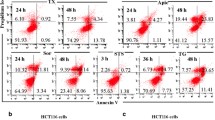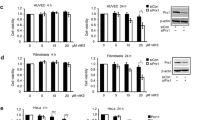Abstract
Thioredoxin (Trx) is a small redox protein that underlies aggressive tumor growth and resistance to chemotherapy. Inhibition of Trx with the chemical inhibitor PX-12 suppresses tumor growth and induces cell apoptosis. Currently, the mechanism underlying the therapeutic actions of PX-12 and the molecules influencing cell susceptibility to PX-12 are incompletely understood. Given that connexin43 (Cx43), a tumor suppressor, regulates tumor cell susceptibility to chemotherapy, we examined the possible involvement of Cx43 in PX-12-induced cell death. Exposure of cells to PX-12 led to a loss of cell viability, which was associated with the activation of oxidative sensitive c-Jun N-terminal kinase (JNK). Inhibition of JNK or supplement of cells with anti-oxidants prevented the cell-killing action of PX-12. The forced expression of Cx43 in normal and tumor cells increased cell sensitivity to PX-12-induced JNK activation and cell death. In contrast, the downregulation of Cx43 with siRNA or the suppression of gap junctions with chemical inhibitors attenuated JNK activation and enhanced cell resistance to PX-12. Further analysis revealed that PX-12 at low concentrations induced a JNK-dependent elevation in the Cx43 protein, which was also preventable by supplementing the cells with anti-oxidants. Our results thus indicate that Cx43 is a determinant in the regulation of cell susceptibility to PX-12 and that the upregulation of Cx43 may be an additional mechanism by which PX-12 exerts its anti-tumor actions.







Similar content being viewed by others
Abbreviations
- NAC:
-
N-Acetyl-1-cysteine
- CA:
-
Carbenoxolone
- Cx:
-
Connexin
- EGFP:
-
Enhanced green fluorescent protein
- GJ:
-
Gap junction
- GSH:
-
Glutathione reduced ethyl ester
- α-GA:
-
α-Glycyrrhetinic acid
- LDH:
-
Lactate dehydrogenase
- PI:
-
Propidium iodide
- ROS:
-
Reactive oxygen species
- Trx:
-
Thioredoxin
- WT:
-
Wild type
References
Penney RB, Roy D. Thioredoxin-mediated redox regulation of resistance to endocrine therapy in breast cancer. Biochim Biophys Acta. 1836;2013:60–79.
Montero AJ, Jassem J. Cellular redox pathways as a therapeutic target in the treatment of cancer. Drugs. 2011;71:1385–96.
Mahmood DF, Abderrazak A, El Hadri K, Simmet T, Rouis M. The thioredoxin system as a therapeutic target in human health and disease. Antioxid Redox Signal. 2013;19:1266–303.
Li C, Thompson MA, Tamayo AT, Zuo Z, Lee J, Vega F, et al. Over-expression of thioredoxin-1 mediates growth, survival, and chemoresistance and is a druggable target in diffuse large b-cell lymphoma. Oncotarget. 2012;3:314–26.
Lim JY, Yoon SO, Hong SW, Kim JW, Choi SH, Cho JY. Thioredoxin and thioredoxin-interacting protein as prognostic markers for gastric cancer recurrence. World J Gastroenterol. 2012;18:5581–8.
Lincoln DT, Ali Emadi EM, Tonissen KF, Clarke FM. The thioredoxin-thioredoxin reductase system: over-expression in human cancer. Anticancer Res. 2003;23:2425–33.
Kirkpatrick DL, Kuperus M, Dowdeswell M, Potier N, Donald LJ, Kunkel M, et al. Mechanisms of inhibition of the thioredoxin growth factor system by antitumor 2-imidazolyl disulfides. Biochem Pharmacol. 1998;55:987–94.
Ramanathan RK, Stephenson JJ, Weiss GJ, Pestano LA, Lowe A, Hiscox A, et al. A phase I trial of px-12, a small-molecule inhibitor of thioredoxin-1, administered as a 72-hour infusion every 21 days in patients with advanced cancers refractory to standard therapy. Investig New Drugs. 2012;30:1591–6.
Ramanathan RK, Kirkpatrick DL, Belani CP, Friedland D, Green SB, Chow HH, et al. A phase i pharmacokinetic and pharmacodynamic study of px-12, a novel inhibitor of thioredoxin-1, in patients with advanced solid tumors. Clin Cancer Res. 2007;13:2109–14.
Gao K, Chi Y, Sun W, Takeda M, Yao J. 5′-AMP-activated protein kinase attenuates adriamycin-induced oxidative podocyte injury through thioredoxin-mediated suppression of the apoptosis signal-regulating kinase 1-p38 signaling pathway. Mol Pharmacol. 2014;85:460–71.
Trosko JE, Chang CC, Wilson MR, Upham B, Hayashi T, Wade M. Gap junctions and the regulation of cellular functions of stem cells during development and differentiation. Methods. 2000;20:245–64.
Yao J, Oite T, Kitamura M. Gap junctional intercellular communication in the juxtaglomerular apparatus. Am J Physiol Renal Physiol. 2009;296:F939–46.
Sirnes S, Bruun J, Kolberg M, Kjenseth A, Lind GE, Svindland A, et al. Connexin43 acts as a colorectal cancer tumor suppressor and predicts disease outcome. Int J Cancer. 2012;131:570–81.
Tang B, Peng ZH, Yu PW, Yu G, Qian F. Expression and significance of cx43 and e-cadherin in gastric cancer and metastatic lymph nodes. Med Oncol. 2011;28:502–8.
Talhouk RS, Fares MB, Rahme GJ, Hariri HH, Rayess T, Dbouk HA, et al. Context dependent reversion of tumor phenotype by connexin-43 expression in mda-mb231 cells and mcf-7 cells: role of beta-catenin/connexin43 association. Exp Cell Res. 2013;319:3065–80.
Lamiche C, Clarhaut J, Strale PO, Crespin S, Pedretti N, Bernard FX, et al. The gap junction protein cx43 is involved in the bone-targeted metastatic behaviour of human prostate cancer cells. Clin Exp Metastasis. 2012;29:111–22.
Yan Q, Gao K, Chi Y, Li K, Zhu Y, Wan Y, et al. NADPH oxidase-mediated upregulation of connexin43 contributes to podocyte injury. Free Radic Biol Med. 2012;53:1286–97.
Li K, Chi Y, Gao K, Yan Q, Matsue H, Takeda M, et al. Connexin43 hemichannel-mediated regulation of connexin43. PLoS One. 2013;8:e58057.
Fang X, Huang T, Zhu Y, Yan Q, Chi Y, Jiang JX, et al. Connexin43 hemichannels contribute to cadmium-induced oxidative stress and cell injury. Antioxid Redox Signal. 2011;14:2427–39.
You BR, Shin HR, Park WH. Px-12 inhibits the growth of a549 lung cancer cells via g2/m phase arrest and ROS-dependent apoptosis. Int J Oncol. 2014;44:301–8.
You BR, Shin HR, Han BR, Park WH. Px-12 induces apoptosis in calu-6 cells in an oxidative stress-dependent manner. Tumour Biol. 2015;36(3):2087–95.
Yao J, Huang T, Fang X, Chi Y, Zhu Y, Wan Y, et al. Disruption of gap junctions attenuates aminoglycoside-elicited renal tubular cell injury. Br J Pharmacol. 2010;160:2055–68.
Krutovskikh VA, Yamasaki H, Tsuda H, Asamoto M. Inhibition of intrinsic gap-junction intercellular communication and enhancement of tumorigenicity of the rat bladder carcinoma cell line bc31 by a dominant-negative connexin 43 mutant. Mol Carcinog. 1998;23:254–61.
Oyamada Y, Zhou W, Oyamada H, Takamatsu T, Oyamada M. Dominant-negative connexin43-EGFP inhibits calcium-transient synchronization of primary neonatal rat cardiomyocytes. Exp Cell Res. 2002;273:85–94.
Huang T, Zhu Y, Fang X, Chi Y, Kitamura M, Yao J. Gap junctions sensitize cancer cells to proteasome inhibitor mg132-induced apoptosis. Cancer Sci. 2010;101:713–21.
Watanabe R, Nakamura H, Masutani H, Yodoi J. Anti-oxidative, anti-cancer and anti-inflammatory actions by thioredoxin 1 and thioredoxin-binding protein-2. Pharmacol Ther. 2010;127:261–70.
Chi Y, Gao K, Li K, Nakajima S, Kira S, Takeda M, et al. Purinergic control of AMPK activation by ATP released through connexin 43 hemichannels—pivotal roles in hemichannel-mediated cell injury. J Cell Sci. 2014;127:1487–99.
Retamal MA, Schalper KA, Shoji KF, Bennett MV, Saez JC. Opening of connexin 43 hemichannels is increased by lowering intracellular redox potential. Proc Natl Acad Sci U S A. 2007;104:8322–7.
Baker AF, Dragovich T, Tate WR, Ramanathan RK, Roe D, Hsu CH, et al. The antitumor thioredoxin-1 inhibitor px-12 (1-methylpropyl 2-imidazolyl disulfide) decreases thioredoxin-1 and VEGF levels in cancer patient plasma. J Lab Clin Med. 2006;147:83–90.
Kim YH, Coon A, Baker AF, Powis G. Antitumor agent PX-12 inhibits HIF-1alpha protein levels through an NRF2/PMF-1-mediated increase in spermidine/spermine acetyl transferase. Cancer Chemother Pharmacol. 2011;68:405–13.
Sin WC, Crespin S, Mesnil M. Opposing roles of connexin43 in glioma progression. Biochim Biophys Acta. 1818;2012:2058–67.
Kandouz M, Batist G. Gap junctions and connexins as therapeutic targets in cancer. Expert Opin Ther Targets. 2010;14:681–92.
Yang L, Wu D, Wang X, Cederbaum AI. Depletion of cytosolic or mitochondrial thioredoxin increases CYP2E1-induced oxidative stress via an ASK-1-JNK1 pathway in HEPG2 cells. Free Radic Biol Med. 2011;51:185–96.
Lin JH, Weigel H, Cotrina ML, Liu S, Bueno E, Hansen AJ, et al. Gap-junction-mediated propagation and amplification of cell injury. Nature Neurosci. 1998;1:494–500.
Krutovskikh VA, Piccoli C, Yamasaki H. Gap junction intercellular communication propagates cell death in cancerous cells. Oncogene. 2002;21:1989–99.
Azzam EI, de Toledo SM, Little JB. Direct evidence for the participation of gap junction-mediated intercellular communication in the transmission of damage signals from alpha-particle irradiated to nonirradiated cells. Proc Natl Acad Sci U S A. 2001;98:473–8.
Autsavapromporn N, de Toledo SM, Little JB, Jay-Gerin JP, Harris AL, Azzam EI. The role of gap junction communication and oxidative stress in the propagation of toxic effects among high-dose alpha-particle-irradiated human cells. Radiat Res. 2011;175:347–57.
Frank DK, Szymkowiak B, Josifovska‐Chopra O, Nakashima T, Kinnally KW. Single‐cell microinjection of cytochrome c can result in gap junction-mediated apoptotic cell death of bystander cells in head and neck cancer. Head Neck. 2005;27:794–800.
Bruzzone S, Guida L, Zocchi E, Franco L, De Flora A. Connexin 43 hemi channels mediate CA2+-regulated transmembrane NAD+ fluxes in intact cells. FASEB J. 2001;15:10–2.
Gao K, Chi Y, Zhang X, Zhang H, Li G, Sun W, et al. A novel TXNIP-based mechanism for CX43-mediated regulation of oxidative drug injury. J Cell Mol Med. 2015;19:2469–80.
Herrero-Gonzalez S, Gangoso E, Giaume C, Naus CC, Medina JM, Tabernero A. Connexin43 inhibits the oncogenic activity of c-src in c6 glioma cells. Oncogene. 2010;29:5712–23.
Gangoso E, Thirant C, Chneiweiss H, Medina JM, Tabernero A. A cell-penetrating peptide based on the interaction between c-src and connexin43 reverses glioma stem cell phenotype. Cell Death Dis. 2014;5:e1023.
Sun Y, St Clair DK, Xu Y, Crooks PA, St Clair WH. A NADPH oxidase-dependent redox signaling pathway mediates the selective radiosensitization effect of parthenolide in prostate cancer cells. Cancer Res. 2010;70:2880–90.
Shan WH, Zhong WX, Zhao R, Oberley TD. Thioredoxin 1 as a subcellular biomarker of redox imbalance in human prostate cancer progression. Free Radical Biol Med. 2010;49:2078–87.
Xu WS, Ngo L, Perez G, Dokmanovic M, Marks PA. Intrinsic apoptotic and thioredoxin pathways in human prostate cancer cell response to histone deacetylase inhibitor. Proc Natl Acad Sci U S A. 2006;103:15540–5.
Shishido SN, Nguyen TA. Gap junction enhancer increases efficacy of cisplatin to attenuate mammary tumor growth. PLoS One. 2012;7:e44963.
Mancuso M, Pasquali E, Leonardi S, Rebessi S, Tanori M, Giardullo P, et al. Role of connexin43 and ATP in long-range bystander radiation damage and oncogenesis in vivo. Oncogene. 2011;30:4601–8.
Sato T, Neschadim A, Lavie A, Yanagisawa T, Medin JA. The engineered thymidylate kinase (tmpk)/azt enzyme-prodrug axis offers efficient bystander cell killing for suicide gene therapy of cancer. PLoS One. 2013;8:e78711.
Acknowledgments
This work was supported by Grants-in-Aid for Scientific Research from the Ministry of Education, Culture, Sports, Science, and Technology, Japan (to 26461219 to J.Y.) and by a grant from the National Natural Science Foundation of China (Grant 81302918 to K.G.).
Author information
Authors and Affiliations
Corresponding author
Ethics declarations
Conflicts of interest
None
Additional information
Gang Li and Kun Gao contributed equally to this work.
Rights and permissions
About this article
Cite this article
Li, G., Gao, K., Chi, Y. et al. Upregulation of connexin43 contributes to PX-12-induced oxidative cell death. Tumor Biol. 37, 7535–7546 (2016). https://doi.org/10.1007/s13277-015-4620-7
Received:
Accepted:
Published:
Issue Date:
DOI: https://doi.org/10.1007/s13277-015-4620-7




